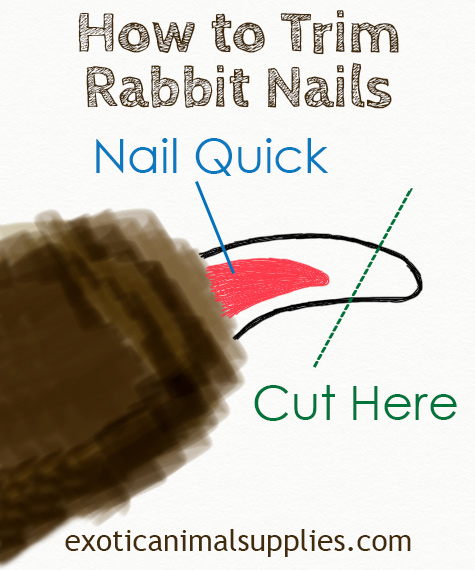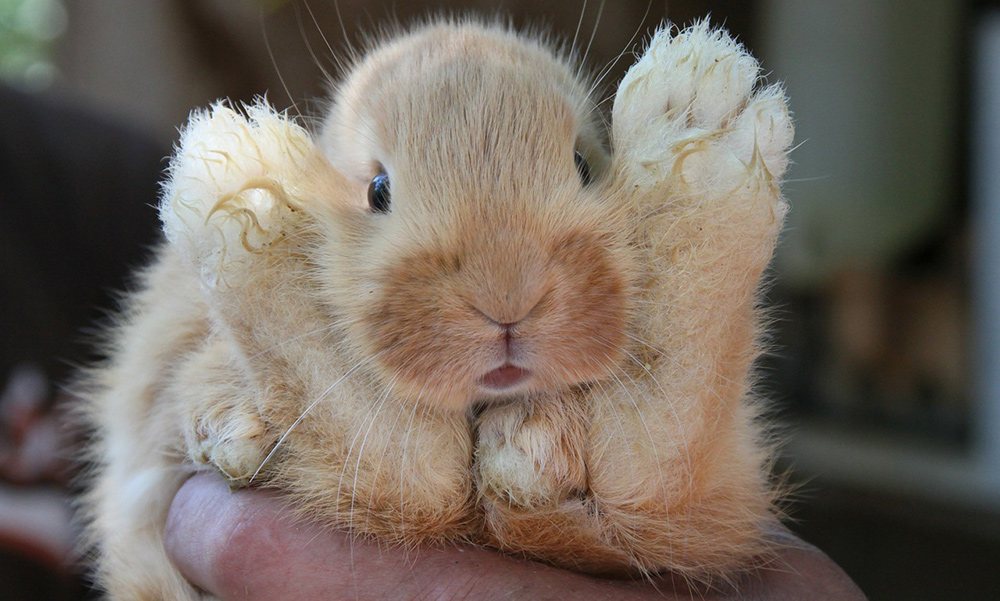Like all pets, rabbits require a little bit of maintenance from their owners in the form of grooming. Fortunately, most rabbit grooming tasks are easy enough to be performed by an owner at home with a few tools on hand. Regularly grooming your rabbit will help prevent health problems, increase your bunny’s happiness, and help you recognize signs of illness and other conditions that need to be looked at by a vet. Make these grooming steps a part of your regular rabbit routine.

Contents
How to Groom a Rabbit
When you add a new pet rabbit to your family, you’ll want to put together necessary care supplies including a rabbit first aid kit. You can add some of these basic grooming tools to your kit:
- Flea Comb or Shedding Brush
- Nail Clippers
- Clean Bath Towel
- Q-Tips & Cotton Balls
How to Brush Your Rabbit
All rabbits shed, but the frequency and quantity of their shedding will depend on their breed. Usually, there will be three big sheds a year as they grow in different coats. For some rabbit breeds, it will seem like they’re always shedding. For others, you can even see the line of shedding happen as it will start at the tip of their nose and move across their body in a line until it reaches the tail.
Since rabbits self-groom by licking themselves, during periods of heavy shedding they can ingest more hair than usual which can cause stomach issues. You’ll also notice tons of hair around your house. One way to help with this process is by brushing your rabbit.
The general recommendation is to brush your rabbit at least once weekly. If you have a long haired rabbit, two times weekly may better help to keep fur mats at bay. During heavy sheds, you may need to do it more frequently–often daily.
There are a few different styles of brushes you can use for grooming your rabbit. The type of brush doesn’t matter too much, as long as your rabbit will allow you to use it on them. Common brushes used by many bunny owners and breeders include flea combs or shedding brushes. Whatever brush you buy, look for a “cat” or “small pet” size for your rabbit. To brush your rabbits face, it’s recommended to use an eyebrow brush/eyelash comb commonly sold for doing make-up. These brushes are gentle for around delicate eyes and small enough to work on cheeks, chins, noses, and around the ears.
During heavy shedding periods, you can pluck hair by hand (demonstrated in this video). Some rabbits do not like this though, so pay attention to your rabbit’s reaction. If they will tolerate it, plucking is a quick way to remove large tufts of hair. Make sure to only gently tug at tufts of hair that are visibly coming loose. If you grab a bit of hair and it doesn’t budge, leave it be. It’s not ready to be shed yet.
To use a brush to remove hair, gently sweep it through the hair, going in the direction of hair growth (from the head toward the tail). Often rabbits do not like it when you try to brush against the grain, even if it removes more hair. Going with the hair growth feels more like you’re petting them and some rabbits find it very relaxing. During periods of heavy shedding, shorter strokes work best. You will need to pause occasionally to clean hair from the rabbit brush or comb. Make sure to brush their bum and the area right above the tail. That area can be harder for the rabbit to reach to groom themselves, especially for older bunnies.
How to Trim Bunny Nails
In the wild, rabbits are constantly digging which wears down their ever-growing nails. Lucky house rabbits live a cushy life with soft furniture, carpets, and rugs, so their nails often don’t wear out naturally and grow long. Long nails are at risk for getting caught, scratching owners, breaking off, and causing pain for the bunny. You should regularly inspect a rabbit’s nails and trim them if they get too long. For most rabbits, they will need a nail trimming every month or every other month. You don’t need fancy tools to trim your rabbit’s nails. A regular set of fingernail clipper for humans works great for rabbits or you can buy pet nail clippers. Make sure you have styptic powder on hand or in your rabbit’s first aid kit before you start.
If you’ve never trimmed your rabbit’s nail before, it might be easier to have a friend or family member help you. While trimming the nails correctly will not hurt the rabbit, they may struggle and want to run away if they’re not used to being held. Try to hold the rabbit in your lap or on a table with a towel laid flat on the surface. Hold the rabbit against your body firmly with one arm. If your rabbit doesn’t like being held, wrapping them in a towel to make a “bunny burrito” can make the task easier.

When you’re trimming a bunny’s nails, the biggest challenge is to not cut them too short. Rabbit nails have a blood vessel in them, also called the quick. If you cut the nail too short it will bleed (which you can stop using styptic powder or corn starch). This is painful for the rabbit and create an opportunity for infection, so we want to avoid it. If your rabbit has light color nails it will make trimming easier since you’ll be able to see the quick through the nail. No matter what color your rabbit’s nails, if you use this technique (also demonstrated in the video above) you will be able to avoid cutting too close.
With your rabbit pressed against you, lift one paw. Place the clipper around the tip of the nail and press gently once and then again. If your rabbit reacts and tries to pull their foot away, you’ve placed the clippers too high. Move them lower and press twice again. If you get no reaction, got ahead and clip the nail.
Your rabbit’s front paw has four forward nails and a fifth dew claw where a human has a thumb. Make sure to check and clip all five nails. The hind legs only have four forward nails. Of your rabbit has long fur on their paws that make their nails hard to see, use a damp washcloth to lightly wet the fur. Watch the video above to see techniques for accessing each foot without stressing your rabbit too much. If your bunny is very resistant to being held, try the burrito technique, or in worst case scenarios you can have the vet clip the nails on their next check-up.
How to Bathe a Rabbit
Many new owners wonder how to clean a rabbit. Fortunately, they are a self-cleaning pet! That means barring special circumstances, your bunny will take care of their own bathing with frequent grooming like cats. In fact, bathing your bunny may cause them undue stress, so it should be avoided unless absolutely necessary.
One of the few occasions you may need to “bathe” your rabbit is when they get a poopy butt that needs to be cleaned by you. This often happens if your rabbit is sick or is overweight or old and cannot clean that area themselves. Eventually, poop will get caked into the fur on their bottom, which you’ll need to wash off. Unless directed to do so by a rabbit savvy vet, do not emerge your rabbit in water. This is extremely dangerous and can lead to shock and even death in rabbits. Instead, for poopy butt, you should give your rabbit what is called a “butt bath.”
Get a litter box or other plastic container just large enough for your rabbit to sit inside. Put a folded towel in the bottom of the box and fill it with an inch or two of tepid/warm water (NOT HOT). Gently place your rabbit in the box, holding the front end of your rabbit up so they’re out of the water (see the video above). Switch water around their butt until the dried on poop is moist. Gently remove the poop with your fingers, being careful not to pull out any hair.
Once their backside is clean, lift them from the box and place them on a dry towel. Dry them with the towel as best you can. Then use a hair dryer set on the lowest heat, until their fur is dry.
Other Grooming Tasks
While brushing and nail clipping will be the main grooming you have to do for your pet rabbit, you’ll also want to examine your rabbits at least once a month to check for sores, injuries, or anything unusual on their bodies.
Each month when you check to see if your rabbit’s nails need to be trimmed, also check the following:
Fur Mats
While any rabbit can get fur mats, long-haired rabbits are most susceptible. Regular weekly or 2X weekly brushing will help to keep fur mats at bay, but if you do discover any you’ll need to remove them. Since rabbits have very delicate skin, it’s dangerous to cut mats out with scissors as you can easily cut their skin. Instead you should use a mat splitter or rake to gently work the mat out of the fur.
Scent Glands
Both male and female rabbits have scent glands under their chin (which they use to mark items and people as “theirs”) and also on either side of their anus. While most rabbits do not have issues with their scent glands, some bunnies have problems grooming them, which can lead to build-up. You’ll easily notice if this is a problem because there’s usually an unpleasant smell (kind of a mix between a skunk and coffee) and a brown build-up in the glands.
Inspect your rabbit’s underside, looking for brown build-up and unpleasant smell. If there’s nothing amiss, don’t worry about it. If your rabbit’s scent glands need cleaning, get some Q-tips and warm water. Securely hold your rabbit on their back so you can access the scent glands. Gently swab away any build-up with the Q-tips.

Sore Hocks on the Feet
Rabbit feet can easily become susceptible to sore hocks. A “hock” is the heel of your rabbit’s foot, which is normally covered by fur that protects the skin. Sore hocks happen when the skin becomes inflamed and painful. While sore hocks can come from neglect, well cared for rabbits can get them too. Common causes are poor hygiene or damp bedding, long nails, rough floors (this is why wired cage floors are a no-no), obesity, immobility, and excessive thumping. My rabbit Barney developed hock sores when he got arthritis as an elderly rabbit, a combination of his immobility and a tendency to sit in his litter box for hours.
If your rabbit develops sore hocks, make sure to consult with your veterinarian to discover the cause and make a plan to remedy the situation. If the skin is broken, raw, or bleeding, see a bunny savvy vet ASAP because the risk of infection means they may need antibiotics. Minor hock sores can be treated with A&D ointment to protect and heal the skin.
Do you have a new pet rabbit in your family? Learn about a healthy rabbit diet, how to rabbit proof your home, and how to clean a rabbit cage.
